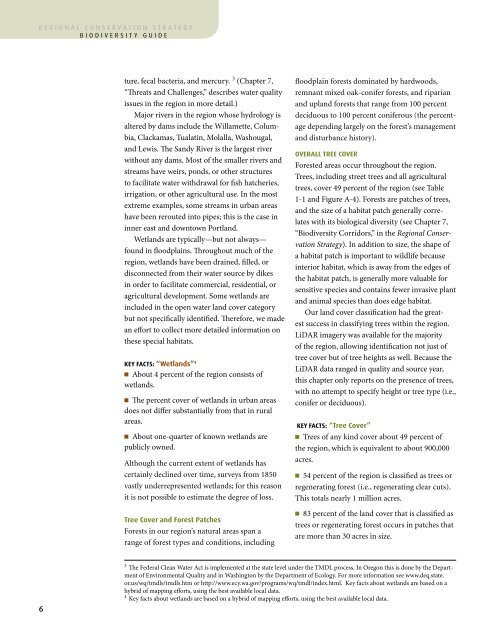Biodiversity Guide - The Intertwine
Biodiversity Guide - The Intertwine
Biodiversity Guide - The Intertwine
Create successful ePaper yourself
Turn your PDF publications into a flip-book with our unique Google optimized e-Paper software.
egional conservation strategybiodiversity guideChapter 1 Current Conditionsture, fecal bacteria, and mercury. 3 (Chapter 7,“Threats and Challenges,” describes water qualityissues in the region in more detail.)Major rivers in the region whose hydrology isaltered by dams include the Willamette, Columbia,Clackamas, Tualatin, Molalla, Washougal,and Lewis. <strong>The</strong> Sandy River is the largest riverwithout any dams. Most of the smaller rivers andstreams have weirs, ponds, or other structuresto facilitate water withdrawal for fish hatcheries,irrigation, or other agricultural use. In the mostextreme examples, some streams in urban areashave been rerouted into pipes; this is the case ininner east and downtown Portland.Wetlands are typically—but not always—found in floodplains. Throughout much of theregion, wetlands have been drained, filled, ordisconnected from their water source by dikesin order to facilitate commercial, residential, oragricultural development. Some wetlands areincluded in the open water land cover categorybut not specifically identified. <strong>The</strong>refore, we madean effort to collect more detailed information onthese special habitats.Key Facts: “Wetlands” 4n About 4 percent of the region consists ofwetlands.n <strong>The</strong> percent cover of wetlands in urban areasdoes not differ substantially from that in ruralareas.n About one-quarter of known wetlands arepublicly owned.Although the current extent of wetlands hascertainly declined over time, surveys from 1850vastly underrepresented wetlands; for this reasonit is not possible to estimate the degree of loss.Tree Cover and Forest PatchesForests in our region’s natural areas span arange of forest types and conditions, includingfloodplain forests dominated by hardwoods,remnant mixed oak-conifer forests, and riparianand upland forests that range from 100 percentdeciduous to 100 percent coniferous (the percentagedepending largely on the forest’s managementand disturbance history).Overall Tree CoverForested areas occur throughout the region.Trees, including street trees and all agriculturaltrees, cover 49 percent of the region (see Table1-1 and Figure A-4). Forests are patches of trees,and the size of a habitat patch generally correlateswith its biological diversity (see Chapter 7,“<strong>Biodiversity</strong> Corridors,” in the Regional ConservationStrategy). In addition to size, the shape ofa habitat patch is important to wildlife becauseinterior habitat, which is away from the edges ofthe habitat patch, is generally more valuable forsensitive species and contains fewer invasive plantand animal species than does edge habitat.Our land cover classification had the greatestsuccess in classifying trees within the region.LiDAR imagery was available for the majorityof the region, allowing identification not just oftree cover but of tree heights as well. Because theLiDAR data ranged in quality and source year,this chapter only reports on the presence of trees,with no attempt to specify height or tree type (i.e.,conifer or deciduous).Key Facts: “Tree Cover”n Trees of any kind cover about 49 percent ofthe region, which is equivalent to about 900,000acres.n 54 percent of the region is classified as trees orregenerating forest (i.e., regenerating clear cuts).This totals nearly 1 million acres.n 83 percent of the land cover that is classified astrees or regenerating forest occurs in patches thatare more than 30 acres in size.3 <strong>The</strong> Federal Clean Water Act is implemented at the state level under the TMDL process. In Oregon this is done by the Departmentof Environmental Quality and in Washington by the Department of Ecology. For more information see www.deq.state.or.us/wq/tmdls/tmdls.htm or http://www.ecy.wa.gov/programs/wq/tmdl/index.html. Key facts about wetlands are based on ahybrid of mapping efforts, using the best available local data.4 Key facts about wetlands are based on a hybrid of mapping efforts, using the best available local data.<strong>The</strong> total amount of tree cover is clearly important,but the size and shape of forest patches alsoinfluence the region’s fish and wildlife, particularlythe more sensitive or declining species. Weanalyzed rough size and shape estimates throughforest patches and interior tree patches respectively,below.Forest PatchesWe differentiate between the tree land cover classificationand forest patches, with the latter beingpatches of trees plus areas of regenerating forest.For this analysis, a forest patch is defined as acluster of trees and/or regenerating forest (i.e.,clear cut) that is at least 30 acres in size. Landcover mapping for this <strong>Biodiversity</strong> Atlas does notdistinguish between 30 acres of 20-year-old treesmixed with weeds and 30 acres of old-growthforest with native understory that includes rareplants. Many of the region’s largest forest patchesare managed for timber harvest. <strong>The</strong>se are workinglands. In terms of mapping, regeneratingforests are successional because under currentforest practices they are continually replanted. Inaddition, clear cuts and natural clearings withina forest are important to species such as elk.Research indicates that 30 acres is a reasonablelow end for what constitutes a large forest patch.Key Facts: “Forest Patches”n Forest patches (larger than 30 acres) cover45 percent of the region (see Figure A-5).n Forest patches cover about 10 percent of urbanareas, compared to 54 percent of rural areas.Forests are not equally distributed throughoutthe region. <strong>The</strong> watersheds that have the highestnumber of acres of forest are the Tualatin,Lewis, Lower Columbia-Sandy, and Clackamas;collectively these watersheds total 57 percent ofthe region and contribute nearly one-third of theregion’s forest. Similarly, some urban areas havemore tree cover than others, particularly wherethere are many streams or large protected naturalareas, such as nature parks.<strong>The</strong> largest contiguous areas of forestlands arein the eastern, northeastern, northern, and westernfringes of the region, in the foothills of theCoast Range and Cascades. However, three majorCoast Range spurs—Chehalem Ridge, ParrettMountain, and the Tualatin Mountains, includingForest Park and Tryon Creek State Park—supportsubstantial forested areas, as do the East Buttesarea of Clackamas County and the Sandy RiverGorge (Figures A-4 and A-5). In Washington,significant forested habitat is found near LacamasLake, Camp Bonneville, Whipple CreekPark, and Ridgefield National Wildlife Complex.Large forested areas also are found near outlyingcities such as Battleground and in areas near theCascade foothills.<strong>The</strong> age of trees and the condition of theunderstory help in determining the species mixand structure of a forest. Most actively managed,commercial, and private industrial forests in thegreater Portland-Vancouver region are composedmostly of Douglas fir trees (or occasionallyponderosa pine) that are between 1 and 60 yearsold. <strong>The</strong>se stands typically have few snags, limitednative shrubs, and scant large wood on the forestfloor. As a result they are unlikely to support6 7




